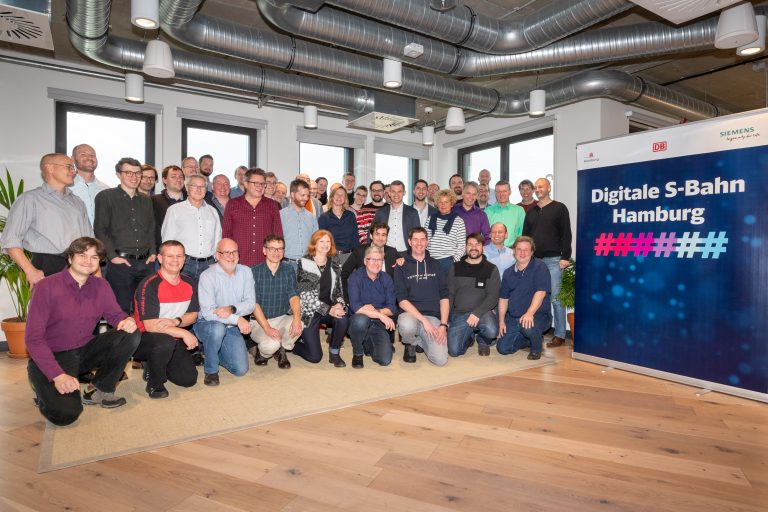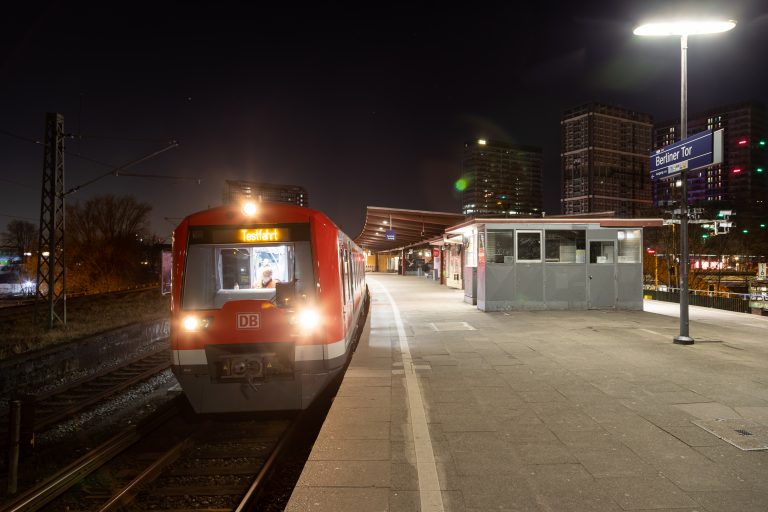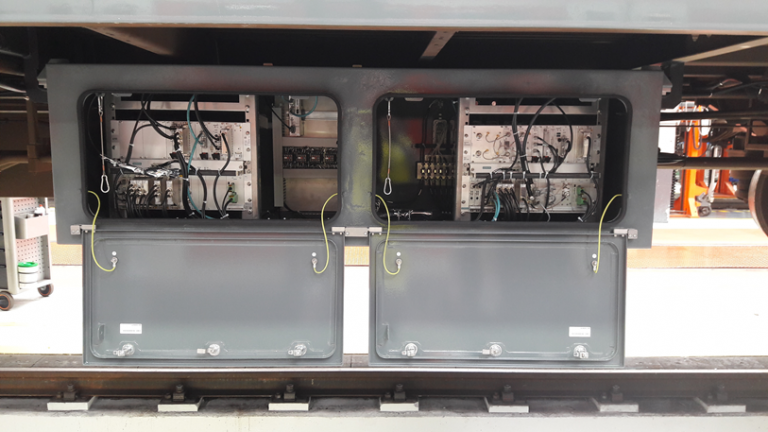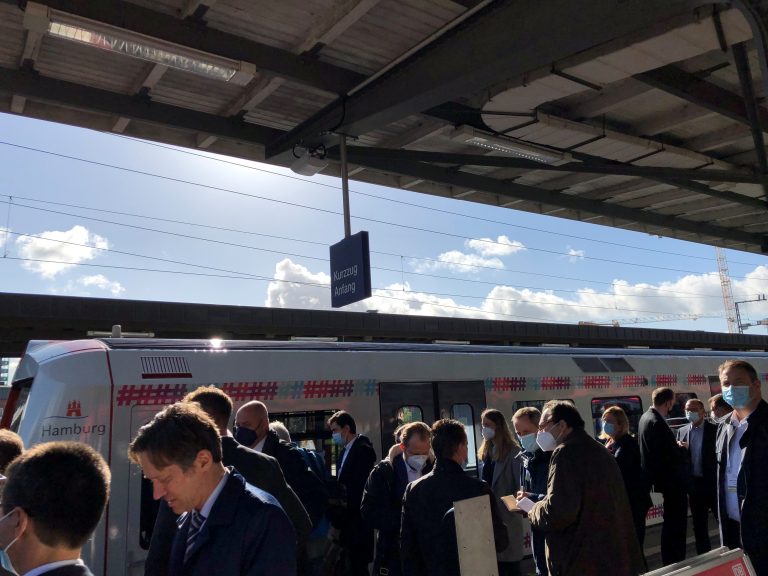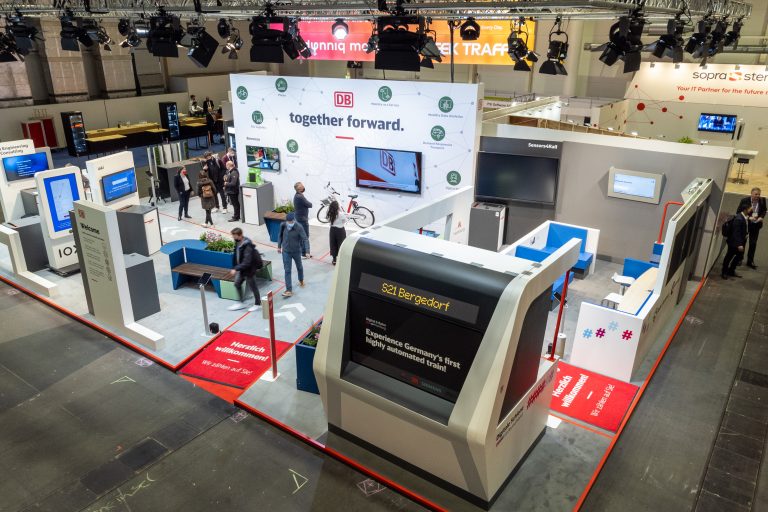
Digital S-Bahn Hamburg
- # # # # # # Hamburg's S-Bahn is blazing a trail for digital rail operations all across Germany
- # # # # # # Highly automated rail operations are starting between Berliner Tor and Aumühle stations
- # # # # # # The S2 and S21 lines will be used as a pilot route
- # # # # # # Fully automated shunting movements will be carried out in Bergedorf
- # # # # # # The German Mobility Award has gone to Hamburg's digital S-Bahn
Innovation in rail transport: Hamburg's Digital S-Bahn is arriving
With a regular-interval timetable and plans for additional lines, Hamburg's S-Bahn service will be significantly enhanced for passengers over the next few years. To create the extra capacity needed for these service improvements, S-Bahn operations must be digitalised. In July 2018, Hamburg entered into a partnership with Deutsche Bahn and Siemens Mobility to do just that. The pilot project for Hamburg's Digital S-Bahn showcases how new technologies can help improve the performance of local public transport in growing cities. During the 2021 ITS World Congress, Hamburg launched automated rail operations on the 23-km-long section of S-Bahn lines S2 and S21 between Berliner Tor and Aumühle. At its core, the project tightly integrates rail infrastructure with rail vehicles by leveraging the European Train Control System (ETCS) and automatic train operation (ATO) system.
Benefits of digitalised rail operations:
- No new construction work required: increased capacity without a single metre of additional track
- Stable, reliable operations: more on-time trains
- Greater energy efficiency: automated acceleration and braking uses less energy
More capacity, better quality, greater efficiency – these are the benefits digitalisation will bring to rail operations. Hamburg's Digital S-Bahn will be the first project to be implemented at Deutsche Bahn as part of the Group's Digital Rail for Germany programme. The city's project represents a milestone for the introduction of innovative technologies in rail operations. Intelligent operations-control technology and a new train control system will optimise the performance of the railway, thus blazing a trail for sustainable mobility services.
The demonstration coincided with the Intelligent Transport Systems (ITS) World Congress, which took place in Hamburg in October 2021. As the world's largest trade fair for intelligent transport systems, the Congress drew participants from politics, science and industry, creating an ideal platform for the project. Funding is being provided by the city of Hamburg, Deutsche Bahn and Siemens Mobility, each of which has contributed an equal share of the total sum of roughly EUR 60 million.
Hamburg, Siemens Mobility and Deutsche Bahn signed a cooperation agreement on the Digital S-Bahn project in July 2018. The agreement is the culmination of the memorandum of understanding on the Smart City partnership, which DB and Hamburg signed in 2017. A feasibility study agreed upon at that time serves as the foundation for the Hamburg Digital S-Bahn pilot project.
Scenes from the project
A fully automated trip to and from the siding and highly automated operations in passenger service
Hamburg's Digital S-Bahn project is the culmination of a cooperation agreement between the city of Hamburg, Siemens Mobility and Deutsche Bahn. In a first for any S-Bahn network in Germany, digital operation is being trialled on part of the Hamburg S-Bahn over the coming months. To achieve this, four trains on the S2 and S21 lines will operate in a highly automated mode on a 23-km-long route section between Berliner Tor and Bergedorf/Aumühle. Train drivers will remain in the cab to monitor the train and will take control only if an incident arises.
In addition, the four trains will operate in fully automated mode when moving to the stabling sidings or transitioning to the platform at Bergedorf station. During these manoeuvres, the S-Bahn's journey will be monitored from the signal box. The train driver and the passengers will then board the train at Bergedorf station platform.
World premiere at the ITS World Congress
On 11 October 2021, the time came to present Hamburg's Digital S-Bahn to the global public. Dr Richard Lutz, Chairman of the Management Board and CEO of DB, and Dr Roland Busch, President and CEO of Siemens AG, presented the Digital S-Bahn Hamburg project train alongside Dr Peter Tschentscher, First Mayor of the Free and Hanseatic City of Hamburg, as it made its debut journey. In addition to highly automated operation on the line to Bergedorf, the demonstration also included fully automated shunting at Bergedorf. Throughout the week, additional demonstration runs were offered to trade fair visitors as part of the ITS World Congress. The demonstration runs not only promoted the Digital S-Bahn Hamburg project but also its sister project Sensors4Rail.
An average of 60 visitors took part in each guided demonstration run and gained a first-hand impression of the technology and new procedures.
ATO over ETCS: the system's core
The technology underpinning the project's implementation is based on the automatic train operation (ATO) system and European Train Control System (ETCS). The electronic signalling system monitors points to ensure they are in the proper position and sets signals for the trains.
The new ETCS computer in the signal box receives train control information, including signal commands and speed limits. The computer transmits the driving instructions by radio to the relevant trains, which it monitors continuously.
In addition to the new radio block centre, ETCS also includes the balises installed along the track. These balises transmit additional static information, such as location, to each vehicle.
Trains carry onboard units for ETCS and ATO. As soon as a train is being monitored by ETCS, its driver can switch on ATO to activate highly automated driving. The train's onboard ATO unit receives current timetable information from the trackside ATO computer, and the vehicle's onboard ETCS computer grants permission to proceed. The ATO system uses this information to create an energy-optimised speed profile. Between Rothenburgsort and Berliner Tor, the driver will resume normal control of the train. The system is similar to the autopilot used in aviation. Train drivers always have the final authority, and they can take back control at any time.
Valuable experience for digitalising rail operations
To implement the pilot project, several different components are being used for digital rail operations. To connect with ETCS, the electronic interlocking must first be upgraded with new technology. On the tracks and onboard the trains themselves, the elements required to implement ATO over ETCS – trackside ETCS and ATO radio block centres, balises and onboard ETCS and ATO computers – are being integrated into existing systems.
DB and Siemens Mobility have formed a research and development partnership for this project. Specialist technicians and engineers are creating a detailed plan for development and implementation. The partners are sharing with each other the knowledge they gain over the course of the project. In this way, both organisations are learning from one another, enabling efficient future advances in the digitalisation of Germany's rail operations.
Infrastructure
Learn more about the technology used on the route.
Trains
More details and background information on the trains.
Outlook

To be continued...
Adding capacity without construction work
DB's aim is to modernise and digitalise its infrastructure from the ground up. By rolling out the European Train Control System (ETCS), digital signalling technology (DSTW) and the integrated control and operating system (ICOS) across its entire network, the company will have completely renewed its control-command and signalling systems by 2035. This means network capacity can be increased significantly without the need to build new rail lines. This major innovation drive will benefit all rail customers in Germany along with the country's businesses and the environment. A more efficient rail sector will mean less traffic on the roads, fewer traffic jams, less air pollution and a substantial reduction in carbon emissions.
What Digital Rail for Germany will mean
With Digital Rail for Germany, we are leveraging the opportunities provided by digitalisation to integrate innovative technologies into the rail system. Artificial intelligence and automatic train operation are set to become the new normal for the railway.
To lay the foundations for this vision, we are modernising and digitalising our infrastructure from the ground up. By rolling out the European Train Control System (ETCS), digital signalling technology (DSTW) and the integrated control and operating system (ICOS) across our network, we will have completely renewed our control-command and signalling systems by 2035. This effort was launched in 2020 in the form of a starter package.
In the second phase of the Digital Rail initiative, the digital rail system will begin tapping into its full potential, revealing the future of the railways. Trains will run closer together in fully automated operation, controlled intelligently and automatically in real time and using sensor technology to detect their surroundings and position. System architecture has been drafted to specify what will be required from individual components of the rail system, and how the components will need to work together. Working from this architecture, a multitude of digital technologies will be tested and improved for use in the rail system.
The Digital Rail for Germany initiative will put more trains on the rails without the need to build new track. Rail network capacity will grow by up to 35% thanks to standardised digital control-command and signalling systems based on ETCS and digital signalling technology, working in concert with ICOS and the innovative technologies of the digital rail system.
Media and Press
 View Hamburg's cooperation agreement on its role as a partner city for digital rail operations in Germany.
View Hamburg's cooperation agreement on its role as a partner city for digital rail operations in Germany. For more information about the future of the railway, visit Digital Rail Germany.
For more information about the future of the railway, visit Digital Rail Germany. Click to learn more about Hamburg's digital S-Bahn at Siemens Mobility.
Click to learn more about Hamburg's digital S-Bahn at Siemens Mobility.





